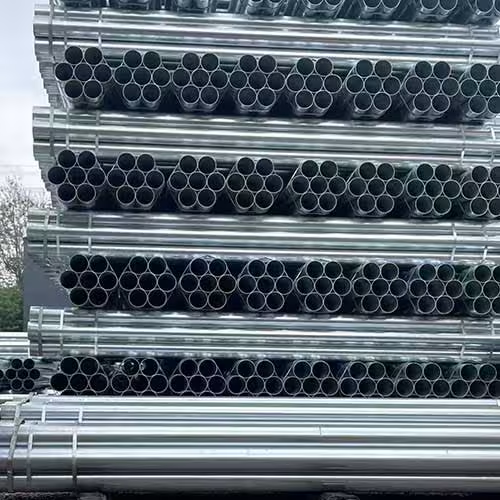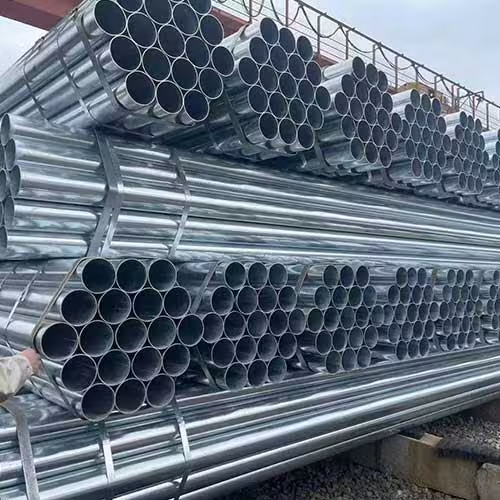Welcome to My Blog!
Before we dive into the content, I’d love for you to join me on my social media platforms where I share more insights, engage with the community, and post updates. Here’s how you can connect with me:
Facebook:https://www.facebook.com/profile.php?id=61565500692293
Now, let’s get started on our journey together. I hope you find the content here insightful, engaging, and valuable.
Table of Contents
Introduction
Think of your home’s plumbing system as the blood vessels of your home, quietly carrying water to every faucet, shower, and appliance. For decades, galvanized steel pipes (steel pipes coated with a protective zinc layer) have been the mainstay of residential and commercial plumbing. Designed to resist rust and corrosion, these pipes were once the preferred choice for water delivery. But over time, homeowners and contractors alike have asked a key question: How long does galvanized pipe last?
Read this blog to find out the answer to the question of how long galvanized pipe lasts.
Understanding Galvanized Pipes and Their Longevity

What Are Galvanized Pipes?
Galvanized pipes are steel pipes coated with a zinc layer through hot-dip galvanizing, a process that shields the steel from rust, per ISO 14657. Think of the zinc as armor, protecting the steel core from corrosive elements like water and oxygen. Key characteristics include:
- Material: Steel core with zinc coating (G01–G360 thickness scale), per ISO 1920-3.
- Applications: Used for water supply lines, drain lines, and occasionally gas lines, per EN 10240.
- Installation Era: Common from the 1920s to 1960s, with some use into the 1980s, per ISO 14657.
- Sizes: Typically ½ to 6 inches in diameter, suited for residential and commercial plumbing, per ASTM A53.
In older homes, galvanized pipes often run through crawl spaces or walls, delivering water to fixtures. Their zinc coating made them a safer alternative to lead pipes, but understanding how long can galvanized pipe last requires examining their vulnerabilities.
Why Ask How Long Can Galvanized Pipe Last?
The question of how long can galvanized pipe last arises because these pipes don’t last forever. Originally expected to endure 50–70 years, many fail sooner due to corrosion, per ISO 14657. Here’s why it matters:
- Homeowners: Aging pipes cause low water pressure, leaks, or rusty water, impacting daily life, per EN 10240.
- Contractors: Assessing pipe condition informs renovation budgets and timelines, per ISO 1920-3.
- Property Managers: Ensuring safe water quality in commercial buildings avoids health risks, per WHO guidelines.
- Sustainability: Replacing outdated pipes reduces water loss from leaks, saving 10–15% of water, per ISO 24510.
In a rural farm setting, knowing how long can galvanized pipe last helps plan irrigation system upgrades, while urban apartments benefit from preventing costly water damage.
Factors Influencing How Long Can Galvanized Pipe Last
The lifespan of galvanized pipes varies widely, from 20 to 80 years, depending on several factors, per ISO 14657. Understanding these helps predict how long can galvanized pipe last in your system:
- Zinc Coating Quality: Thicker coatings (e.g., G360) last longer than thinner ones (e.g., G01), per ASTM A123.
- Water pH: Acidic (pH < 7) or alkaline (pH > 7) water accelerates zinc and steel corrosion, per ISO 1920-3.
- Hard Water: High mineral content (calcium, magnesium) causes scale buildup, restricting flow, per EN 10240.
- Temperature: Hot water lines corrode 20–30% faster due to higher oxygen levels, per ISO 14657.
- Installation Quality: Nicks or abrasions during installation expose steel, hastening rust, per ASTM A53.
- Environment: Pipes in damp areas (e.g., under slabs) degrade faster due to moisture, per ISO 24510.
In commercial kitchens, hot water and frequent use shorten how long can galvanized pipe last, while cold water lines in residential basements may endure longer.
Assessing How Long Can Galvanized Pipe Last in Practice
Typical Lifespan of Galvanized Pipes
On average, galvanized pipes last 40–50 years, though well-maintained systems can reach 60–80 years, per ISO 14657. However, real-world conditions often reduce this timeline:
- Early Failure: Poor galvanizing or acidic water can cause corrosion in 20–30 years, per ASTM A123.
- Standard Range: Most pipes from the 1960s are now 50–60 years old, nearing replacement, per EN 10240.
- Exceptional Cases: High-quality pipes in neutral water (pH 7) may last 70+ years, per ISO 1920-3.
A suburban home built in the 1950s likely has galvanized pipes approaching the end of their life, making it critical to evaluate how long can galvanized pipe last for that property.
Signs Your Galvanized Pipes Are Nearing the End
Knowing how long can galvanized pipe last involves recognizing signs of failure, per ISO 24510. Look for these indicators:
- Low Water Pressure: Internal rust and scale reduce pipe diameter, restricting flow by 20–30%, per EN 10240.
- Rusty Water: Brown or reddish water signals internal corrosion, per ISO 1920-3.
- Leaks: Thinning walls or joint corrosion cause pinhole leaks, per ASTM A53.
- Rust Spots: External corrosion, especially at joints, indicates zinc coating loss, per ISO 14657.
- Hard Water Signs: Mineral deposits on faucets suggest internal scale buildup, per EN 10240.
In a multi-family building, tenants reporting discolored water or weak showers may signal that it’s time to investigate how long can galvanized pipe last.
Testing to Determine How Long Can Galvanized Pipe Last
To accurately assess how long can galvanized pipe last, professional testing is key, per ISO 1920-3. Methods include:
- Visual Inspection: Plumbers check for rust or pitting, especially at joints, per ASTM A53.
- Water Testing: Lab analysis detects iron or lead from corrosion, per WHO guidelines.
- Flow Testing: Measures pressure to assess internal blockages, per EN 10240.
- Magnet Test: Confirms galvanized steel (magnetic) vs. copper or PVC, per ISO 6465.
In a historic property, a plumber’s inspection can pinpoint whether galvanized pipes are still viable or if their lifespan is exhausted, guiding decisions on how long they can last.
Galvanized Pipe Lifespan Comparison Table
To better understand how long can galvanized pipe last, the following table compares galvanized pipes with alternative plumbing materials—copper, PEX, and brass—based on their typical lifespan, resistance to corrosion, maintenance requirements, and ideal applications, per ISO 14657 and EN 10240. Tailored for homeowners renovating older properties or contractors upgrading commercial systems, this table provides a clear overview to assess how long can galvanized pipe last relative to modern options. No pricing is included, focusing instead on technical attributes to guide decisions for residential, commercial, or industrial plumbing needs.
| Pipe Material | Typical Lifespan (Years) | Corrosion Resistance | Maintenance Needs | Best Applications |
|---|---|---|---|---|
| Galvanized Pipe | 35–70 | Moderate; zinc coating protects against rust initially, but internal corrosion occurs over time, per ASTM A123 | High; requires regular checks for rust, scale buildup, and leaks, per ISO 1920-3 | Water supply and drain lines in pre-1980s buildings |
| Copper Pipe | 50–100 | High; naturally resists corrosion, though acidic water may cause pinhole leaks, per EN 1057 | Low; minimal maintenance unless exposed to corrosive water, per ISO 14657 | Hot and cold water supply lines, HVAC systems |
| PEX Pipe | 40–50 | Excellent; non-metallic, immune to rust and scale, per ISO 15875 | Very low; occasional fitting inspections needed, per EN 10240 | Flexible water lines, radiant floor heating |
| Brass Pipe | 80–100 | High; durable but susceptible to dezincification in high-mineral water, per ISO 1920-3 | Low; periodic checks for fittings in hard water areas, per ASTM B88 | Industrial water systems, high-durability supply lines |
Maintaining Galvanized Pipes to Extend Their Lifespan
Regular Maintenance for How Long Can Galvanized Pipe Last
Maintenance is like exercise for your plumbing—consistent effort extends how long can galvanized pipe last, per ISO 24510. Key practices include:
- Annual Inspections: Plumbers check for leaks, rust, or pressure drops, per EN 10240.
- Water Treatment: Softeners reduce hard water scale by 15–20%, per ISO 1920-3.
- Flushing Pipes: Running water clears sediment, preventing blockages, per ASTM A53.
- pH Adjustment: Neutralizing water (pH 7) slows corrosion, per ISO 14657.
In a commercial building, annual maintenance can add 5–10 years to how long can galvanized pipe last, delaying costly replacements.
Repair Options to Prolong How Long Can Galvanized Pipe Last
When issues arise, repairs can extend how long can galvanized pipe last, per ISO 1920-3. Options include:
- Epoxy Lining: Coats internal surfaces to prevent rust, adding 10–15 years, per EN 10240.
- Spot Repairs: Replace small sections with copper or PEX, per ASTM A53.
- Dielectric Couplings: Prevent galvanic corrosion at joints with other metals, per ISO 14657.
- Sealants: Temporary fixes for pinhole leaks, per ISO 24510.
In an older school, epoxy lining can extend how long can galvanized pipe last, maintaining water quality without full replacement.
When Maintenance Isn’t Enough
Even with care, galvanized pipes eventually fail, per ISO 14657. Signs that maintenance can’t extend how long can galvanized pipe last include:
- Frequent Leaks: Multiple repairs indicate widespread corrosion, per EN 10240.
- Severe Blockages: Scale reduces flow below 50% of capacity, per ASTM A53.
- Health Risks: Lead or iron in water from corrosion, per WHO guidelines.
- Structural Damage: Leaks cause mold or foundation issues, per ISO 24510.
In a retail store, persistent low pressure and rusty water signal that it’s time to replace pipes, as maintenance can no longer sustain how long can galvanized pipe last.
Why Knowing How Long Can Galvanized Pipe Last Matters

Health and Safety Implications
Understanding how long can galvanized pipe last is critical for health, like checking food expiration dates, per WHO guidelines. Risks include:
- Lead Contamination: Older zinc coatings may contain lead, leaching into water, per ISO 14657.
- Bacterial Growth: Rust and scale harbor bacteria, per EN 10240.
- Water Quality: Rusty water affects taste and safety, per ISO 1920-3.
- Structural Risks: Leaks cause mold or property damage, per ISO 24510.
In a daycare, ensuring galvanized pipes are replaced before failure protects children’s health, underscoring why knowing how long can galvanized pipe last is essential.
Economic Benefits of Monitoring Pipe Lifespan
Assessing how long can galvanized pipe last saves money, like maintaining a car to avoid breakdowns, per ISO 24510. Benefits include:
- Preventive Savings: Replacing pipes before leaks avoids 20–30% higher repair costs, per EN 10240.
- Water Efficiency: New pipes reduce water loss by 10–15%, per ISO 1920-3.
- Property Value: Modern plumbing boosts resale value by 5–10%, per ASTM A53.
- Energy Savings: Better flow reduces pump energy use by 10%, per ISO 14657.
In an office building, proactive replacement based on how long can galvanized pipe last prevents tenant disruptions and costly emergency repairs.
Environmental Impact of Galvanized Pipe Longevity
Replacing aging galvanized pipes aligns with sustainability, like upgrading to energy-efficient appliances, per ISO 24510. Environmental benefits include:
- Reduced Water Waste: New pipes cut leak losses by 15–20%, per EN 10240.
- Lower Emissions: Efficient water flow reduces energy for pumping, per ISO 1920-3.
- Recyclability: Steel pipes are 100% recyclable, per ASTM A53.
- Safer Water: Eliminates lead risks, per ISO 14657.
In a community center, understanding how long can galvanized pipe last supports eco-friendly upgrades, conserving resources and ensuring safe water.
Conclusion
The lifespan of galvanized pipes is more than just a technical challenge; it is the cornerstone of maintaining a safe, efficient and sustainable plumbing system. Generally, the lifespan of galvanized pipes ranges from 20 to 80 years, with durability depending on the quality of the zinc, water conditions and maintenance. Whether you are the owner of a historic building or a contractor managing a commercial property, understanding the lifespan of galvanized pipes will ensure that your water quality, property and budget are protected.
FAQ
How long can galvanized pipe last on average?
Galvanized pipes typically last 40–50 years, though well-maintained systems can endure 60–80 years, depending on water quality and how they were installed. Regular checks help maximize how long can galvanized pipe last in your home or building.
What factors affect how long can galvanized pipe last?
The lifespan depends on the zinc coating’s thickness, water’s acidity or alkalinity, mineral content in hard water, water temperature, installation care, and exposure to moisture. These elements determine how long can galvanized pipe last before corrosion sets in.
How can I tell if my galvanized pipes need replacing?
Signs include low water pressure, brown or rusty water, frequent leaks, visible rust spots on pipes, or mineral deposits on faucets. These indicate that your steel pipes may be nearing the end of how long can galvanized pipe last.
Can maintenance extend how long can galvanized pipe last?
Yes, annual inspections, water softeners to reduce mineral buildup, flushing pipes to clear sediment, and adjusting water chemistry can add 5–15 years to your plumbing system’s life, helping extend how long can galvanized pipe last.
Are galvanized pipes safe for drinking water?
Older galvanized pipes may release small amounts of lead or iron as they corrode, which can affect water safety. If your pipes are over 40 years old, consider replacing them to ensure how long can galvanized pipe last doesn’t compromise health.

